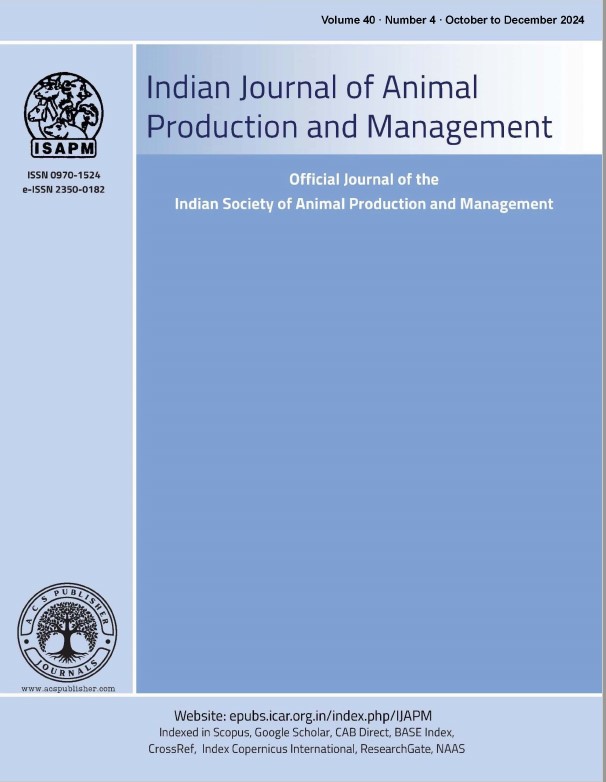Fatty Acid Profile of Milk of Various Indigenous Cattle Breeds in Hot-Arid Region of Rajasthan
DOI:
https://doi.org/10.48165/ijapm.2024.40.2.1Keywords:
fatty acids, indigenous cattle, monounsaturated fatty acids, polyunsaturated fatty acids, saturated fatty acidsAbstract
The bioactive components refer to compounds either naturally existing in food or introduced during food processing that may have physiological and biochemical functions when consumed by humans and have crucial impacts on human metabolism and beneficial effects on human health, that guard neonates and adults against pathogens and illnesses and Antioxidants may positively affect human health by protecting the body against damage caused by reactive oxygen species, which attack membrane lipids, protein and DNA. Bioactive components encompass proteins, peptides, carbohydrates, lipids, glycolipids and other minor biomolecules i.e. vitamins, lactoferrin, enzymes, immunoglobulin and growth factors. The present study was conducted on fatty acids in milk of various indigenous cattle breeds viz. Kankrej, Sahiwal and Rathi. For fatty acids, 36 milk samples (12 from each breed) were collected from different Livestock Research Station, Bikaner. Fatty acids were measured by GC-MS. The analysis of variance revealed monounsaturated fatty acids and Poly unsaturated fatty acids significantly differed in different indigenous cattle breeds whereas saturated fatty acids did not differ. The present study concluded that the milk from the indigenous cattle breeds viz. Kankrej, Sahiwal, and Rathi have distinct compositions and quantities of different active components which can be harnessed for the promotion of different functional foods based on indigenous cattle milk and further pharmaceutical preparations can be promoted for the benefit of farmers and entrepreneurs.
References
Alyaqoubi, S., Aminah Abdullah, A., Samudi, M., Abdullah1, N., Addai, Z.A. and Al-ghazali, M. (2014) Effect of Different Factors on Goat Milk Antioxidant Activity. International Journal of Chem.Tech.Research. 6(5):3091-3196.
Arnould, V. M. R. and Soyeurt, H. (2009). Genetic variability of milk fatty acids. J. Appl. Genet. 50:29–39.
Bernabucci, U., Lacetera, N., Ronchi, B. and Nardone, A. (2002). Effects of hot season on milk protein fractions in dairy cows. Anim. Res. 51:25–33.
Bulut, S., Kanber, G., Tirindaz, C., Kara, H. H., Mert, R. and Konuk, M. (2015). Investigation of fatty acids of milk from different cow breeds. Arch. Lebensmittelhyg. 66: 168–171.
De-Peters, E. J., Medrano, J. F. and Reed, B. A. (1995). Fatty acid composition of milk fat from - three breeds of dairy cattle. Can. J. Anim. Sci. 75: 267-269.
Feng, S., Lock, A. L. and Garnsworthy, P. C. (2004). A rapid method for determining fatty acid composition of milk. J. Dairy Sci. 87(11):3785– 3788.
Gottardo, P., Penasa, M. Righi, F. Lopez-Villalobos, N. Cassandro, M. and De Marchi M. (2017). Fatty acid composition of milk from Holstein Friesian, Brown Swiss, Simmental and Alpine Grey cows predicted by mid-infrared spectroscopy. Ital. J. Anim. Sci. 16:380– 389.
Hanna, N., Ahmed, K., Anwar, M., Petrova, A., Hiatt, M. and Hegyi, T. (2004). Effect of storage on breast milk antioxidant activity. Arch. Dis. Child Fetal Neonatal Ed. 89:F518–F520.
Hein, L., Sorensen, L.P., Kargo, M. and Buitenhuis, A.J. (2018). Genetic analysis of predicted fatty acid profiles of milk from Danish Holstein and Danish Jersey cattle populations. J. Dairy Sci.
(3):2148–2157.
Huth, P. J. and Park, K. M. (2012). Influence of dairy product and milk fat consumption on cardiovascular disease risk: a review of the evidence. Adv. Nutr. 3:266–285.
Kirchnerová, K. and Vršková, M. (2015). Milk fatty acid profile in different breeds of dairy cattle. J. Microbiol. Biotech. Food Sci. 4 (3):78-81.
O'Fallon, J. V., Busboom, J. R., Nelson, M. L. and Gaskins, C. T. (2007). A direct method for fatty acid methyl ester (FAME) synthesis: Application to wet meat tissues, oils and feedstuffs. J. Anim. Sci. 85(6):1511-21.
Palladino, R. A., Buckley, F., Prendiville, R., Murphy, J. J., Callan, J. and Kenny, D. A. (2010). A comparison between Holstein-Friesian and
Jersey dairy cows and their F(1) hybrid on milk fatty acid composition under grazing conditions. J. Dairy Sci. 93:2176-2184.
Palmquist, D. L., Beaulieu, A. D. and Barbano, D. M. (1993). Feed and animal factors influencing milk fat composition. J. Dairy Sci. 76:1753-71.
Ramos, T. M., Costa, F. F., Pinto, I. S. B., Pinto, S. M. and Abreu, L. R. (2015). Effect of Somatic Cell Count on Bovine Milk Protein Fractions, J. Anal. Bioanal. Tech., 6(5) 1-7.
Singh, N., Sharma, S., Dhakad, G. S., Karnani M. and Rao S. K. (2023). Associate of electric conductivity, Milk pH and Milk constituents with udder health in zebu cattle. Haryana vet. 62(1): 35-37.
Singh, N., Sharma, S., Sharma, V., Agarwal, M. Gupta S.R. and Sharma, P. C. (2022). Antioxidant and free radical scavenging profile of milk in various indigenous cattlebreeds. Indian J Dairy Sci. 75(6): 542-546.
Singh, N., Sharma, S., Sharma, V., Baindha, A., Dhakad, G. S. and Jeph N. K. (2022). Fat Soluble Vitamins Profile of Milk in Various Indigenous Cattle Breeds of Rajasthan. J Anim Res. 12(6): 843-847.
Singh, N., Sharma, S., Sharma, V., Sharma, A. and Dhakad, G.S. (2022). Impact of biometric characteristics of udder and teats on milk quality of indigenous dairy cattle. Indian J Dairy Sci. 75(5): 486-48.

